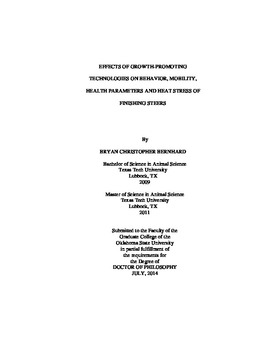| dc.contributor.advisor | Krehbiel, Clinton R. | |
| dc.contributor.author | Bernhard, Bryan Christopher | |
| dc.date.accessioned | 2015-06-17T20:04:52Z | |
| dc.date.available | 2015-06-17T20:04:52Z | |
| dc.date.issued | 2014-07 | |
| dc.identifier.uri | https://hdl.handle.net/11244/14726 | |
| dc.description.abstract | Crossbred steers (n=336; initial BW 379 plus or minus 8kg) were used in a RCBD to determine the effects of growth-promoting technologies on steers' behavior, mobility, health parameters and heat stress. Treatments consisted of an all-natural treatment (NAT), a conventional treatment (implanted with 40mg of estradiol and 200mg of trenbolone acetate (TBA), and fed 33 and 9mg/kg of monensin and tylosin daily, CONV) and a CONV treatment plus the addition of zilpaterol hydrochloride (ZH; at 6.8g/ton [90% DM-basis] for the last 20 days on feed with a 3 to 4 d withdrawal; CONV-Z). Chute exit scores resulted in a treatment time interaction (P= 0.03), with NAT steers having a more aggressive exit score than CONV and CONV-Z steers at d 10Z and d 20Z. There were no effects of treatment on exit velocity, pen temperament, or overall temperament (P greater than or equal to 0.26). Standing time and lying bouts were not affected by treatment (P> 0.45), but CONV-Z steers took more steps/d (P= 0.04), resulting in a greater motion index (P= 0.05) than NAT steers. While moving to the working facilities, CONV-Z steers moved at the slowest velocity, CONV were intermediary, and NAT the fastest (P< 0.05). Step length and mobility scores were not affected by treatment (P greater than or equal to 0.14). White blood cell counts were greater for CONV and CONV-Z versus NAT steers from d 28 through d 20Z (P< 0.05). Liver abscesses, lung scores and heart and liver histological changes were not affected by treatment (P greater than or equal to 0.10). During summer heat stress, body temperature was not affected (P> 0.10), but respiration rate was greatest for CONV-Z steers, intermediate for NAT and lowest for CONV steers (P< 0.05). Hair covering scores was lower for CONV and CONV-Z versus NAT cattle from d 84 through d 20Z. The results of this experiment suggest that growth-promoting technologies have little to no overall effects on cattle behavior, mobility and health parameters. Treatment altered the mechanism by which steers exchange heat load to maintain thermo-homeostasis, but all steers experienced a similar magnitude of heat stress. Collectively, growth-promoting technologies did not have a negative effect on finishing steer well-being during this study. | |
| dc.format | application/pdf | |
| dc.language | en_US | |
| dc.rights | Copyright is held by the author who has granted the Oklahoma State University Library the non-exclusive right to share this material in its institutional repository. Contact Digital Library Services at lib-dls@okstate.edu or 405-744-9161 for the permission policy on the use, reproduction or distribution of this material. | |
| dc.title | Effects of growth-promoting technologies on behavior, mobility, health parameters and heat stress of finishing steers | |
| dc.contributor.committeeMember | Horn, Gerald W. | |
| dc.contributor.committeeMember | Step, Douglas L. | |
| dc.contributor.committeeMember | Calvo-Lorenzo, Michelle S. | |
| dc.contributor.committeeMember | Goad, Carla Lynn | |
| osu.filename | Bernhard_okstate_0664D_13612.pdf | |
| osu.accesstype | Open Access | |
| dc.type.genre | Dissertation | |
| dc.type.material | Text | |
| dc.subject.keywords | beef cattle | |
| dc.subject.keywords | beta-agonist | |
| dc.subject.keywords | heat stress | |
| dc.subject.keywords | mobility | |
| dc.subject.keywords | natural | |
| dc.subject.keywords | welfare | |
| thesis.degree.discipline | Animal Science | |
| thesis.degree.grantor | Oklahoma State University | |
